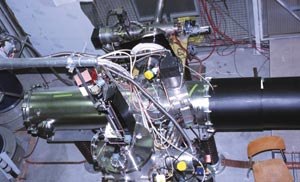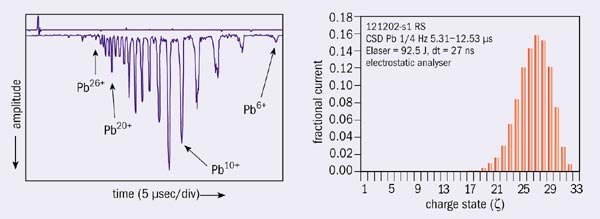
On 22 August the last of three Russian trucks left CERN for Moscow carrying, as a long-term loan, a laser ion source in 93 boxes with a total volume of 150 m3 and a weight of 42 tonnes. This marked the end of more than 10 years of R&D work on a high current, high charge state, heavy ion source that has the potential to provide beam for the Large Hadron Collider (LHC) and other heavy ion accelerators demanding extremely high beam intensities, such as the Terawatt Accumulator, TWAC, at Moscow. At the same time, the journey marked the beginning of a new phase in the life of the laser ion source (LIS).
Only three different types of source are thought able to reach the performance needed for high-intensity heavy ion machines: the electron-beam ion source (EBIS); the LIS, which has been studied in close collaboration between CERN and Russia; and the electron cyclotron resonance ion source (ECRIS), which is used in combination with an accumulator ring to fatten the beam.
In the LIS developed at CERN, intense laser radiation heats the target surface causing the emission of atoms and a plasma containing low charge-state ions. This plasma is then heated by the laser radiation, such that the ions are ionized 20-30 times. These ions are then extracted by an electrostatic field before acceleration by a radio-frequency quadrupole (RFQ).

For many years studies were done with a commercially available CO2 laser providing a 30 J pulse every 30 seconds, but its energy, pulse form and pulse repetition rate were far from the parameters required to produce an ion beam for LHC. The present Heavy Ion Linac at CERN, LINAC3, feeding the PS Booster in single-turn injection, would need a 5 µs long pulse with some 1010 lead ions in charge state 25+, every second. For this reason the two Russian institutes in the collaboration, ITEP and TRINITI, designed and built a CO2 laser capable of delivering 100 J pulses in 27 ns with a 1 Hz repetition rate. The project was co-funded by the European Union and CERN.
With the new laser, power densities of 1013 W/cm2 were obtained on the target of the ion source. For 1 Hz pulse trains lasting more than 60-70 minutes, statistical fluctuations in pulse amplitude and pulse width from shot to shot were less than ±15%.
The two measured charge-state distributions of ions shown in the figure demonstrate the progress over the past 10 years. The second distribution was obtained in December 2002, shortly before the source was shut down. Extrapolating current densities from the measuring point (an electrostatic analyser) to real extraction geometries leads to 1-2 x 1010 Pb27+ in a pulse of 3-4 µs. The fact that with an RFQ and an interdigital-H-type (IH) RF structure, as used in LINAC3, three different charge states can be accelerated simultaneously up to the first stripper, gives confidence that LHC conditions can be fulfilled comfortably. Nevertheless, converting the laser prototype to a device satisfying LHC reliability standards, interfacing this source to LINAC3, and accelerating the ions to the energy needed at the entrance of the IH structure, meant further R&D. CERN, at present under pressure to reduce R&D work for the sake of LHC progress, decided to use LINAC3 (with an ECRIS) and LEIR, the former Low Energy Antiproton Ring, as the first heavy ion source. This freed the LIS for an immediate application at TWAC.
With the new CERN/ITEP Collaboration Agreement, the LIS will be used not only to produce medium-mass ions as required by TWAC for its daily operation, but also for R&D on source performance, which will continue in parallel. Le roi est mort, vive le roi!





